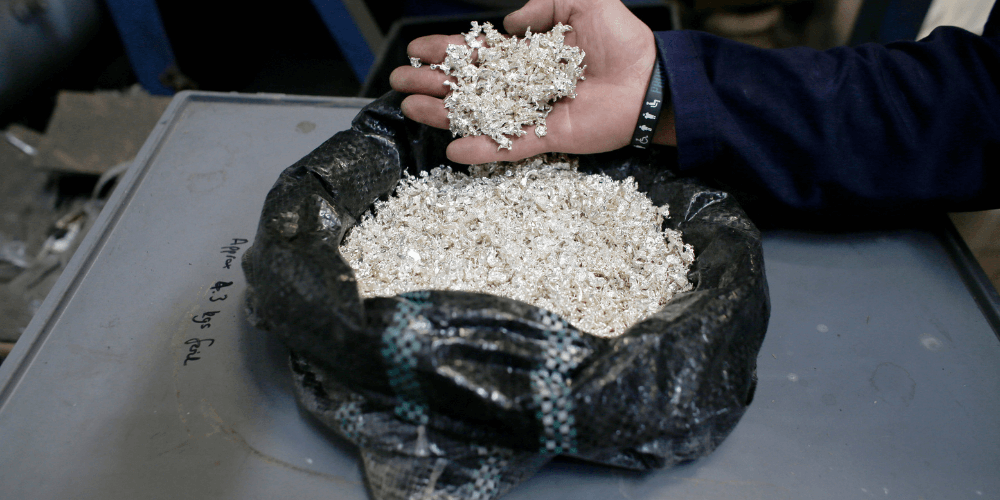
The contents of this article, accurate at the time of publishing, is for general information purposes only, and does not constitute investment, pensions, legal, tax, or any other advice. Before making any investment or financial decision, you may wish to seek advice from your financial, pensions, legal, tax and/or accounting advisors.
Precious Metal Prices
August witnessed an eventful week for the main metals on the global market. The price of gold started the month at $1956.75 and experienced a noticeable drop in the first few days, settling at $1931.70 by the 7th. This drop was in stark contrast to the highs of $2044.70 achieved in May. Similarly, silver observed a dip from an opening of $24.51 on the 1st to $23.39 by the 7th, marking a significant decline from its April highs of $26.02. On the other hand, platinum demonstrated relative stability throughout the month, with its price hovering around the $930 mark, albeit a significant decrease from April's peak of $1106.
This month’s metals market's fluctuations can be attributed to multiple economic events. Gold's allure as a safe-haven asset was boosted by Fitch's downgrade of the U.S.' AAA credit rating, causing ripples in the confidence of the U.S. economy. Concurrently, the U.S.'s robust Q2 GDP growth of 2.4% fortified the dollar, exerting pressure on gold prices. Additionally, stronger U.S. private payroll numbers hinted at potential monetary policy tightening, negatively impacting gold. The month also saw the Bank of England raising its base rate, adding another layer of complexity to the global financial landscape. These movements in the metals' prices underscore the delicate interplay between global economic indicators, fiscal decisions, and geopolitical uncertainties.
Central Bank Update
China's central bank, the People’s Bank of China (PBoC), has been at the forefront of gold acquisition, boosting its reserves for the ninth consecutive month in July, with an addition of 740,000 troy ounces. This continued accumulation underpins gold prices, especially as China diversifies its reserves amidst global interest rate hikes. Alongside China, central banks globally purchased a net 55 tons of gold in June, a rebound from three months of net selling. The Central Bank of Türkiye, after being a net seller between March and May, returned to net buying in June, reinforcing the ongoing trend in central bank gold demand. Notably, six central banks, including the PBoC and the National Bank of Poland, were significant buyers, while Kazakhstan and Singapore were among the few sellers. This net buying comes in a climate where central banks, particularly in emerging markets, are diversifying away from the U.S. dollar due to geopolitical tensions and macroeconomic uncertainties, emphasising gold's role as a stable reserve asset. The World Gold Council projects that central bank buying will persist, albeit possibly at a slower pace.
The precious metal movements of Central banks are important as banks accumulate gold for several strategic reasons. Firstly, gold offers portfolio diversification, potentially reducing the risks associated with heavy reliance on a single currency, notably the US dollar. During economic or geopolitical crises, it can serve as a reliable emergency asset, useful for international payments or bolstering national currencies. This has been especially notable in recent months due to the evolving situation in Russia and Ukraine. Additionally, gold possession often signifies economic strength and prestige on the global stage. Given the unpredictable global scenarios, central banks often view gold as a safeguard against uncertainties in the wider market.

Divergent Golden Tides: China's Surge vs. India's Dip
In the first half of 2023, China’s almost insatiable appetite for gold saw consumption surge by over 16% to 554.88 tons, fuelled by swelling incomes and a shift from equities and bonds amidst global uncertainties. In sharp contrast, India's demand for the precious metal showed a decline of 7% in Q2 2023, totalling 158.1 tonnes. The World Gold Council pinpointed the decline to the record-high prices of gold in the Indian Rupee, which significantly impacted consumer sentiment. While gold bar and jewellery consumption in China rose by 15% and 30% respectively, India saw its jewellery demand drop by 8% and investment demand slide by 3% in the same period.
However, this dip in demand has not stunted gold's recycling activity in India. There was a marked 61% uptick in gold recycling during the quarter, with many consumers looking to capitalise on historically high gold prices. Despite these numbers, experts remain hopeful, indicating that a successful monsoon season could revitalise demand, especially with the festive Diwali season approaching. Meanwhile, China's gold journey is punctuated by the nation's strategic move away from dollar assets, with its gold reserves swelling for the ninth straight month, reaching 2,137 tons by the end of July 2023. As China celebrates its market reopening post a three-year lockdown and revels in the gold and jewellery sector's resurgence, India remains cautiously optimistic, awaiting the potential turn of the tide.
Gold's Timeless Appeal: As Crypto Interest Wanes
August's stabilisation in the cryptocurrency market, particularly Bitcoin, has been a notable talking point amongst investors. Once dubbed the "digital gold," Bitcoin is finally mirroring some characteristics of the precious metal. A recent report by Bloomberg, using data from digital assets research firm K33, highlighted that Bitcoin's 30-day volatility has plummeted to a near five-year low. This stability means that Bitcoin is currently steadier than the S&P 500, Nasdaq Composite, and even gold itself.
However, this newfound sturdiness comes with an underlying narrative: the waning interest in cryptocurrencies. Bitcoin trading volume has slumped to levels reminiscent of November 2020. This decline in enthusiasm can be traced back to the tumultuous events of 2022 when sharp interest rate hikes and the collapse of significant entities like FTX led to a drastic plunge in Bitcoin's price. Presently, even with endorsements from giants like BlackRock, Bitcoin continues to hover around $30,000, a stark contrast from its peak of $69,000 in November 2021.
While Bitcoin's recent low volatility might have momentarily aligned it with gold's characteristic steadiness, it's essential to acknowledge the fundamental differences. Gold's stability and value proposition as a safe haven is underpinned by millennia of human history and innate physical value. The drop in cryptocurrency interest underscores the volatile nature of new asset classes and reinforces the enduring value proposition of gold and other precious metals. As digital interest wanes, it's a testament to the long-standing security and assurance gold offers in turbulent times.

The Royal Mint's Sustainable Shift: From X-Rays to Silver
In line with the rising demand for sustainably sourced precious metals and an ever-conscious world, The Royal Mint has launched an innovative collaboration with Betts Metals. This partnership will transform medical x-ray films, often stored by hospitals beyond their retention date, into beautifully crafted pieces for its '886 by The Royal Mint' jewellery collection. This not only offers an eco-friendly alternative to traditional mining but also exemplifies The Royal Mint's dedication to a circular economy. This endeavour builds on The Royal Mint's commitment to sustainability, highlighted by their upcoming launch of a precious metals’ recovery plant in 2023, and previous initiatives like retrieving gold from electronic waste. As investors and consumers alike pivot towards sustainable choices, The Royal Mint continues to lead the way in marrying tradition with innovation.
READ MORE:
- July 2023 Market Update | The Royal Mint
- Bank of England’s Latest Rate Decision | The Royal Mint
- Is it Cheaper to Buy Bullion in the Summer? | The Royal Mint
- Why do Investors Place More Value on the Safe-Haven and Diversifying Qualities of Gold? | The Royal Mint
This article may include references to third-party sources. We do not endorse or guarantee the accuracy of information from external sources, and readers should verify all information independently and use external sources at their own discretion. We are not responsible for any content or consequences arising from such third-party sources.
